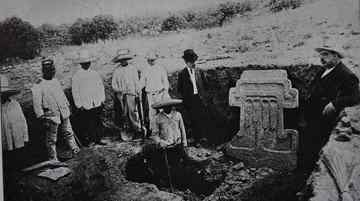The most visited archaeological site of Mexico, Teotihuacan, was opened to public 100 years ago, in September 13th 1910, after exploration, excavation, restoration and conservation work conducted by archaeologist Leopoldo Batres from 1905 to 1910.
 Since then, the Pre-Hispanic city has undergone continue research conducted by Batres, Manuel Gamio, Sigvald Linne, Alfonso Caso, Pedro Armillas, Eduardo Nogera, Ignacio Bernal, Jorge Acosta, Ruben Cabrera, Eduardo Matos, Guadalupe Mastache, Juan Vidarte and Laurette Sejourne, among others.
Since then, the Pre-Hispanic city has undergone continue research conducted by Batres, Manuel Gamio, Sigvald Linne, Alfonso Caso, Pedro Armillas, Eduardo Nogera, Ignacio Bernal, Jorge Acosta, Ruben Cabrera, Eduardo Matos, Guadalupe Mastache, Juan Vidarte and Laurette Sejourne, among others.
Explorations have lead to the recent finding at la Ciudadela of a tunnel more than 1,800 years old, project in charge of INAH archaeologist Sergio Gomez.
To commemorate the first century of scientific investigations at the site part of the United Nations Educational, Scientific and Cultural Organization (UNESCO) List of World Cultural Heritage since 1987, the National Institute of Anthropology and History (INAH) has organized academic activities that will begin in September 23rd when a commemorative plaque will be unveiled.
Conferences will take place in September 23rd and 30th, as well as in October 7th, with the participation of remarkable archaeologists that have developed research at Teotihuacan, as Eduardo Lopez Moctezuma, Ruben Cabrera, Alejandro Villalobos, Linda Manzanilla and Arturo Menchaca, among others, who will create a historical panorama of the most relevant archaeological findings registered in the last 100 years.
In September 23rd 2010 the exhibition “Museo de Sitio, 100 Años de Historia” (Site Museum, 100 Years of History) will be opened, gathering 32 historical photographs from the INAH National Photo Library, The National Library of Anthropology and History and the National Newspaper Library of Mexico. The exhibition is to be opened until November 2010 at the Site Museum.
Celebrations include talks and visits designed for youngsters and children from communities near the Prehispanic city. From September to December 2010, authorities of the archaeological site will guide groups of students from nearby primary schools, to invite them to know and value their cultural heritage.
The exhibition “Tras la Huella de Tlaloc” (Following the imprints of Tlaloc), organized by INAH and UNAM (National University of Mexico) is also part of the commemorations and will be open from November 2010 to May 2011. The fundamental features of Tlaloc were found in Teotihuacan at first, and this will be the first multimedia exhibition displayed at the archaeological zone.
Source: Art Daily [September 11, 2010]